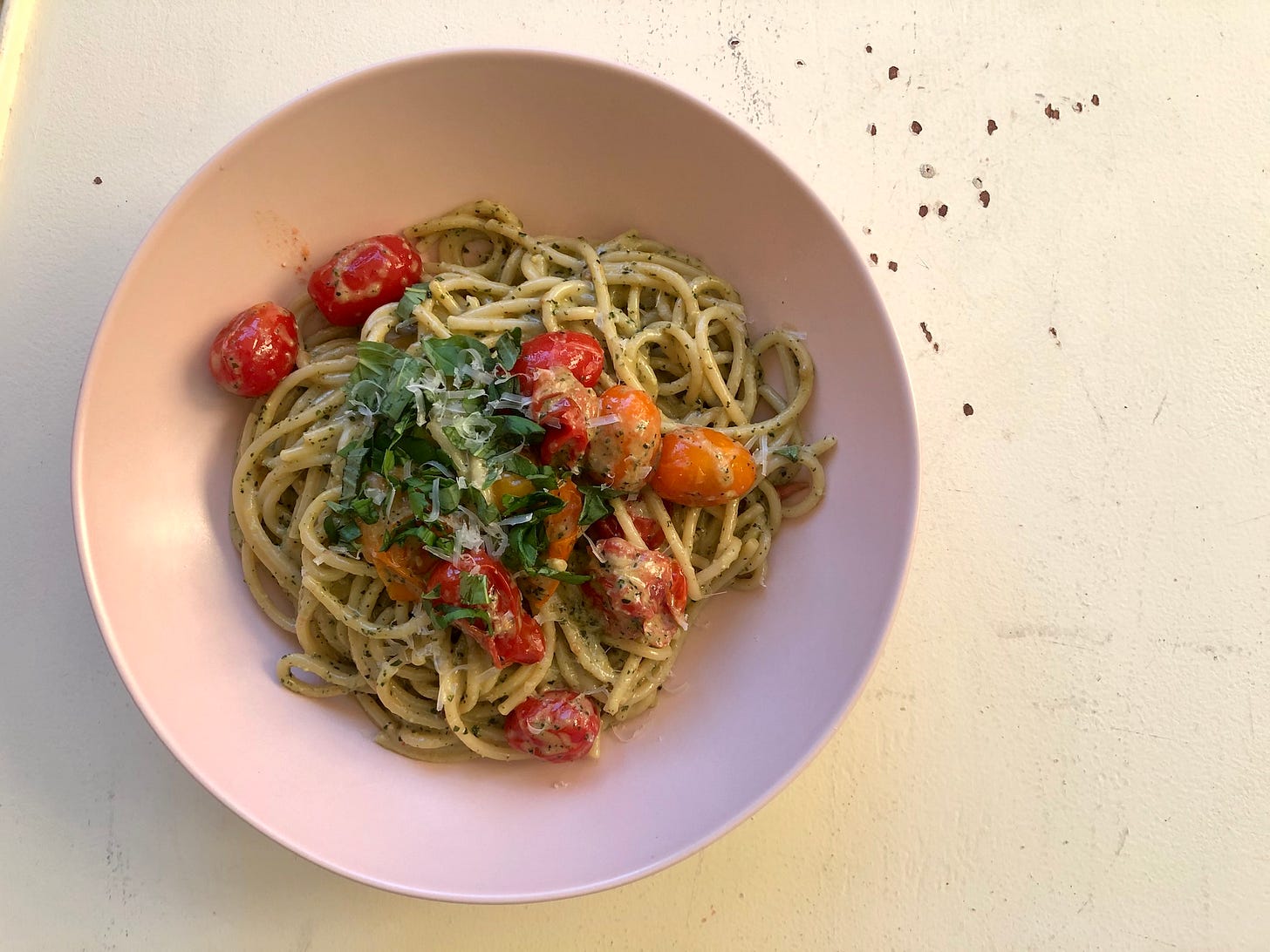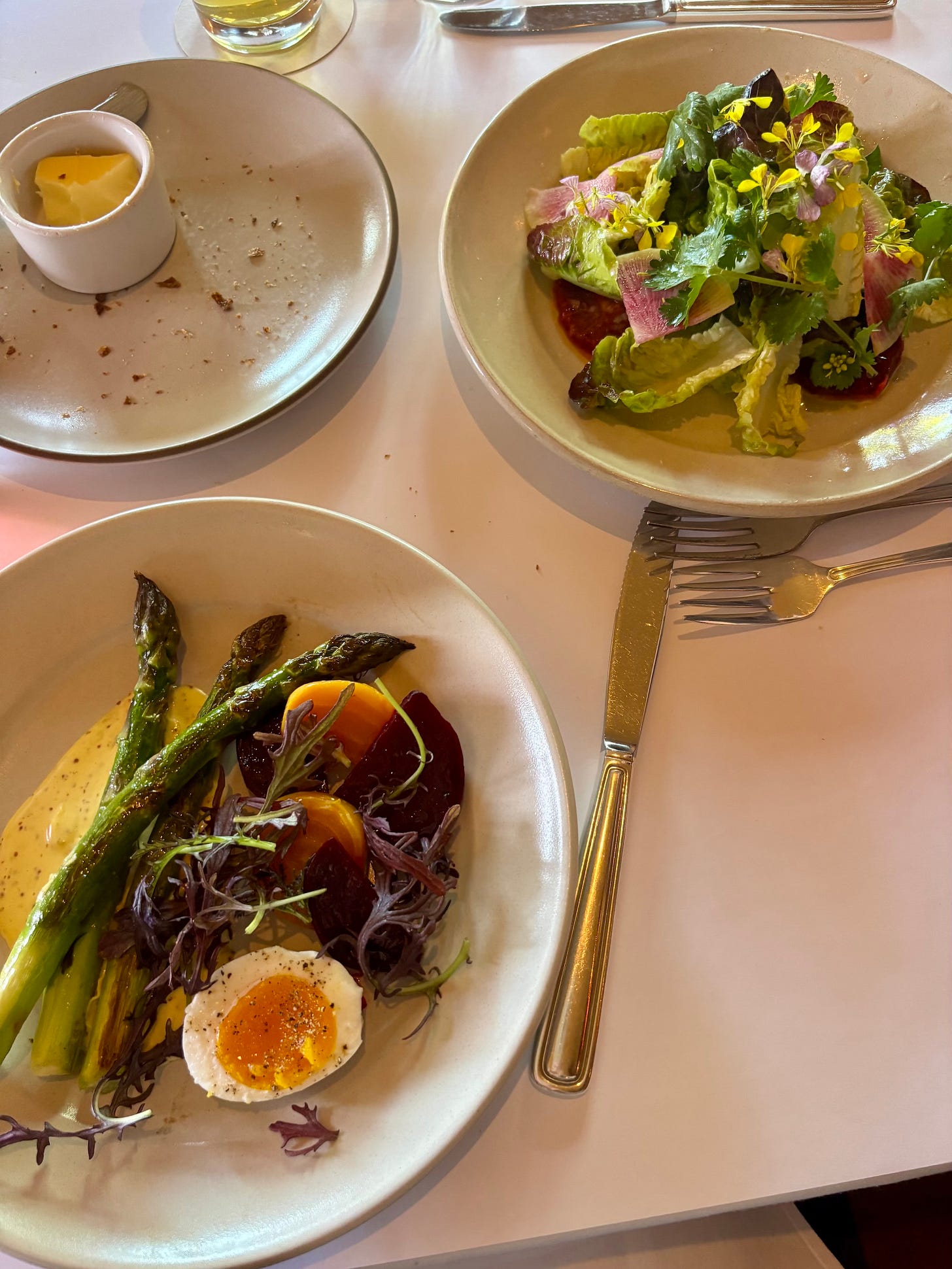Last week I attended a cookbook talk on Milk Street Backroads Italy, the latest cookbook release from James Beard award-winning organization Milk Street.
I learned about Milk Street in the past couple years, thanks to their cookbooks Tuesday Nights (my partner and I have a few staples in weeknight rotation from this one) and Milk Street Vegetables, which my cookbook club cooked from last year. So I’m no stranger to Milk Street, and having been satisfied with the recipes I’ve eaten from these books, I expected learning about their Italian cookbook would be no different.
So you can imagine my surprise when I walked away from this talk a little taken aback. You see, it had nothing to do with the book itself. The book was a beautiful work of art. I flipped through it while listening to the author J.M. Hirsch speak, my mouth watering over the lemon pasta and tiramisu. It was complete with photos and stories of the Italians he and his team met on their culinary research expedition.
Instead, it was some of the words and sentiment he shared that left a sour taste in my mouth. At one point during the conversation, Hirsch made a statement about Italians—they’re just like us! He explained that they too are busy people and take shortcuts in the kitchen, buy canned tomatoes, etc. He went so far as to claim that we Americans over-romanticize other cultures’—namely, Italians—ways of eating.
Upon hearing this, I immediately felt an adverse reaction in my body. So much so that I was still thinking about it a few days later. I even went so far as to reach out to my Substack friend
, an American ex-pat currently living in Napoli, to ask about her experience with Italian food culture. Just as I predicted, she disagreed with Hirsch’s opinion and gave several examples of the slow, local food culture present in Napoli and other parts of Italy, noting that they take a lot of pride in homemade food.(I think it's no coincidence that the founder of Slow Food International, Carlo Petrini, is Italian after all.)
During my senior year of college I studied abroad in Italy, where I spent 3 months living in a dorm in a small mountainside town, Paderno del Grappa, in the Veneto region. While dorm cafeteria life and a college budget prevented me from totally immersing myself in the Italian culinary scene, I could still sense their approach to food was different than back home.
The biggest thing I remember as an impressionable young woman who had never before been outside North America, was the hours of our local tabacchi, essentially a convenience store and deli. Every day they closed for a few hours around lunch time, as well as all day Sunday. An American ever used to constant availability, this frustrated me and my classmates at first. How could they close up shop at lunch time, precisely when we wanted to go there for a deli sandwich? But then we learned and adjusted our shopping habits accordingly. It was really no big deal, it just took some foresight. And now, years later, I have the maturity and life experience to realize what a gift this was; imagine if more businesses here in the States closed up at lunchtime? It centers family time and the power of rest, while encouraging that others do the same. If you can’t shop at lunch, you have no choice but to slow down and take a proper lunch break like the shop-owners themselves.
The other vivid food memory I have of life in my Italian campus bubble was the menu at our local pizzeria. All their pizzas were traditional Neapolitan options except for one—the “pizza Americano.” It was simply a margherita pizza topped with French fries and was a favorite amongst us college students, particularly on late nights when the drinks were pouring. I too loved it but even then, was wise enough to recognize they were catering to the rotating American population that lived in town and this was not a normal Italian cuisine. I always felt like they were welcoming and poking fun at us at the same time.
Seeing that the tiramisu recipe in the Milk Street cookbook was inspired by a local in the Veneto region brought me back to one my favorite food experiences there. My last week abroad, some of the staff treated a small group of us at a cafe in a neighboring town, where I ate the most delicious piece of tiramisu I’d ever had. I considered it my farewell to Italy, and since then I've always had a soft spot for the dessert. It immediately brings me back to that tiny little cafe, where I took all the time in the world to eat it at my leisure.
Flipping through the Milk Street cookbook, it was clear that Hirsch respected Italian cooking traditions, having centered the people he met frequently throughout the book. I trusted that he treated them with the utmost courtesy. However, I felt like maybe he didn’t truly understand them.
It was as if the cookbook he had written was selling us Americans on the false hopes that these recipes are the way to cooking like Italians, versus honoring their underlying values around food itself.
I worried that perhaps I was being a bit harsh, and second-guessed my adverse reaction to the talk. Because his words themselves weren’t obviously offensive (no one else in the room seemed to mind; they seemed infatuated with his stories). But another voice in my head told me to honor the way I was feeling. That my reaction needn’t be justified. Rather than question whether my reaction was “fair” or the “right” one, I decided instead to reflect on why I was having that reaction.
Thankfully, I just so happened to be reading Alice Waters’ We Are What We Eat: A Slow Food Manifesto, that gave me the language to explain what I was feeling.
In this book, Waters, the pioneer of the farm to table movement, details the different values that make up what she calls “fast food culture” versus “slow food culture.”
Fast food culture, as she defines it, doesn’t refer only to fast food establishments, but also encompasses that and any type of food that is processed or industrially produced. Think McDonald’s, deli sandwich meat, year-round bananas and avocados in the Pacific Northwest. Slow food culture, on the other hand, refers to food that is ethically grown and honors its relationship with nature. Think local, seasonal produce, farmer's markets, and chickens and cows that roam free.
The core of her argument is that the food culture we participate in, i.e. the way we choose to eat, reverberates into the rest of our lives, meaning that we subconsciously ingest the values of this culture, often without ever realizing it.
As she writes so succinctly:
“And once those values are a part of you, they change you. You begin to have a different outlook on things, different cravings, different moral standards and expectations. Now your desires and hungers are being programmed by this fast food culture, and you may not even realize it; it’s subconscious. […] You begin to accept these values as truths: that everything should be available to us, all the time; that more is always better; that food should look and taste the same, no matter the season, wherever we are in the world; that time is money, and speed should be cherished above all else; that our choices, food-related and otherwise, have no consequences.”1
Ultimately, I realized that what was at play was a mismatch in food values between me and Hirsch. By stating that we over-romanticize Italians’ way of eating, he casually dismissed their values and posited himself squarely in fast food culture.
To give him the benefit of the doubt, I wouldn’t be surprised if Hirsch didn’t realize he was doing so. It takes a lot of conscious effort to uncouple from fast food values since they have been ingrained in our culture, especially here in America, for the past century.
It’s a culture that I’m actively trying to reject with my daily choices. A practice that isn’t easy and takes a lot of intentionality.
Cultivating a slow food mindset is something I’ve done slowly, but surely, in my adulthood. Almost on accident, for I can’t remember what got me started questioning the origins of my food. It’s something I think I’ve accelerated in the past few years especially, by adopting a CSA share, reading books like this one, and venturing into my own veggie gardening.
It wasn’t until reading Waters’ book that I thought to put a name to my food values. I’ve known I fall into the slow food camp by nature of the choices I make when it comes to feeding myself, but my experience at the talk reminded me that enjoying good food or cooking doesn't necessarily mean you value slow food over fast food culture.
The values of slow food culture, as Waters describes them, are: beauty, biodiversity, seasonality, stewardship, pleasure in work, simplicity, and interconnectedness. Contrast that with those that characterize fast food culture: convenience, uniformity, availability, trust in advertising, cheapness, more is better, and speed.
In all the values Waters chronicles between these lifestyles, taste/flavor isn't one of them. Likely because palates are subjective and come from experience. I find that the more I eat in a “slow food way,” i.e. seasonal and local, the better it tastes and feels, thus reinforcing my desire to continue the habit.
Therefore, I would define flavor as one of the guiding forces behind my food choices. But is it a value? Looking back at the previous essays I've written on this topic, I mention the phrase “food values” more often than I recalled. But what I didn't do was define those values.
We Are What We Eat inspired me to try naming what it is I do value. Flavor is a pretty good start, don't you think?
Author’s Note: I had the pleasure of eating at Alice Waters' restaurant, Chez Panisse, for the first time a few weekends ago while spending a long weekend in San Francisco. When I realized the restaurant was just a short BART ride away in Berkeley, I knew I had to seize the chance to go.
We opted for lunch in the cafe, versus the prix fixe dinner, to save a bit of money. Dining there is what prompted me to select her book next off my shelf. I loved that I could picture the walls within Chez Panisse whenever Waters mentioned it throughout her text. A special place indeed!
Alice Waters, We Are What We Eat: A Slow Food Manifesto (Penguin Press, 2001), 12








I will forever idolize/romanticize the Italian way of preparing and eating food. The way they see it as an artform and way to connect with others feels so much healthier to me. Plus, in sourcing food locally and preparing it slowly, it just tastes so much better. I studied abroad in Florence and was lucky to live in a pensione run by a woman who cooked us all amazing homemade meals. My friends would make fun of me because I would always subconsciously say "mmmm" as I ate – I couldn't help it! What can I say, pasta is my love language 🍝
Interesting about the Milk Street talk ... I don't know if I've ever intentionally thought about fast food culture vs slow food culture ... but I can taste the difference. There are probably people in Italy that don't appreciate slow food but I'd guess overall there's more attention to that way of eating. Thanks for sharing. I need to read the Alice Waters' book!